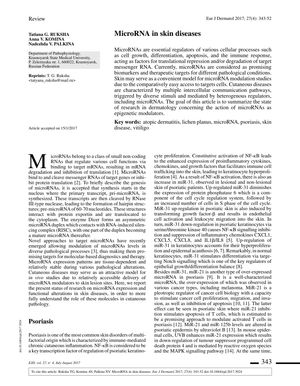MicroRNA in Skin Diseases
July 2017
in “
European Journal of Dermatology
”

TLDR Certain microRNAs are linked to various skin diseases and could be used to diagnose and treat these conditions.
The document from July 2017 provides an in-depth review of the role of microRNAs (miRNAs) in various skin diseases, including psoriasis, atopic dermatitis, allergic contact dermatitis, melanoma, Merkel cell carcinoma (MCC), systemic and localized scleroderma, Hailey-Hailey disease, male pattern baldness, vitiligo, and cutaneous T-cell lymphoma. It identifies specific miRNAs that are dysregulated in these conditions, such as miR-31 and miR-21 in psoriasis, miR-155 in atopic dermatitis, and miR-203 in MCC, and discusses their impact on disease pathogenesis by affecting processes like keratinocyte proliferation, immune response, and apoptosis. The document suggests that miRNAs have significant potential as biomarkers for diagnosis and monitoring treatment efficacy in skin diseases. However, it also notes the need for further research to establish a clear correlation between serum and tissue miRNA levels. Specific miRNAs like miR-125b, miR-196a-2, and miR-150 are highlighted for their roles in oxidative stress, vitiligo, and cutaneous T-cell lymphoma, respectively, indicating their potential as therapeutic targets. The study was supported by the Russian Science Foundation and reported no conflicts of interest.





